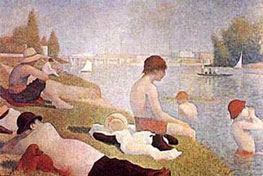

 |
 |
 |
 |
|
Post-Impressionists
and the
Unified Field
Many
of us in the 21st Century have been doing spiritual work designed
to produce this same effect of viewing all reality as a unified
field of light, and we have even, on occasion, succeeded. Maybe
if all humanity could see this unified field, rather than the usual
discriminating mode that separates objects from background, and
objects from other objects, we could begin to realize a similar
kind of unity with each other, within ourselves, and the world. Perhaps the Pointillists’ revolutionary vision could be attributed to their having ingested moldy rye bread and bread made from poorly stored wheat that got damp, or to the fact that they reportedly enjoyed absinthe, a fermented alcoholic drink made from anise, which was popular around the turn of the century. The view from this brew is certainly powerful enough to escalate one’s senses to the point of seeing the material world as particles of electrified light. Whatever the cause — shift of consciousness, or organic intervention — a small group of artists in the last decades of the 20th Century, led by Georges Seurat and Paul Signac, attempted to portray what they were actually seeing in painted fields of large and small dots. We
know that none of us sees reality directly. We can only see external
reality through then lens of our visual sense, our eyes. We also
know our eyes are not holes in our head, like windows. Rather, they
are more akin to digital cameras, spread far enough apart to present
us with two slightly different sides of an object, which makes it
appear in our mind that we are seeing three dimensions, when we
are really only seeing two. Because of the general crudity of our
visual sense we assume that the world is solid, that because an
object ‘feels’ solid, that it is solid. In this same way,
we have a tendency to think that the earth on which we stand is
solid, unless of course we live in California and know how quickly
that "solid earth" can turn into a liquid mass of particles! We
have a tendency to think that space is empty because we cannot see
the molecules that fill it, yet with an increase in visual concentration,
another world can appear. Things brighten and there in our mind,
where we really see images on the frontal lobe, is a particulate
molecular image so tightly packed that it first appears solid, and
then translucent, until it brightens so much it disappears altogether
in a sea of light. This
is the Unified Field.
This
unified field is what the Pointillists painted... a world of perception
beyond ordinary vision. Because we cannot see things outside our
body directly, we see them within our mind, and therefore the view
of reality we hold is dependent on the clarity and level of our
body/mind. It is like we reside in the pineal, looking out at a
screen in front of us. Whatever our eyes see, we see on that screen
and nowhere else. Our optical system is so composed as to make us
see it in dimensions—the locations of the cameras give us the
view of dimension and distance—while our tactile sense tells
us it is there and how it is. Vincent
Van Gogh’s perceptions and work followed lines laid out by
the Pointillists, only his vision was more intense and he portrayed
his reality in brilliant tones, with an extraordinary force that
moved dynamically across his paintings. He was a man looking directly
at the plasma of his mind; notice how fluid his later paintings
became—like liquid color. Even today most people look at his
work in awe. Something about his paintings touch them, effects movement
in their minds, having nothing to do with his subjects. It
is popularly understood that Van Gogh was insane – but he couldn’t
have felt much understand from others, holding that vision, at that
point in history. Not finding any support for his perceptions in
the culture around him must have isolated and alienated him and
helped contribute to his withdrawal from normal life and becoming
"insane". He was probably better off when he was alone
than when trying to interact and become integrated into his culture. But things are somewhat different now, and Van Gogh may have been more at home in the digital age of today. We are now much more sophisticated scientifically. We know, for example, that this message I’m writing on the computer screen is composed of tiny electronic dots of light, or lack of light. This black lettering, for example, is actually covering up the white light dots from the cathode ray tube in our monitors as it sprays the inside of the coated glass tube. Unless of course you are viewing this on a laptop, in which case you are seeing electrified particles charging a sensitive gel media. Intellectually, at least, we are a little closer to comprehending the view of reality shown by the Pointillist’s unified field of tiny colored dots. |

